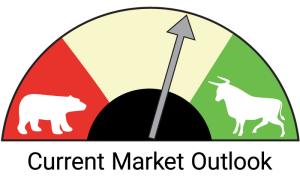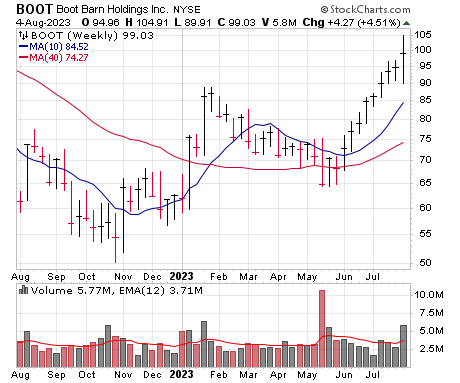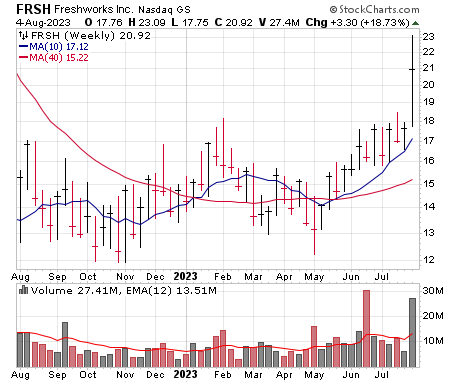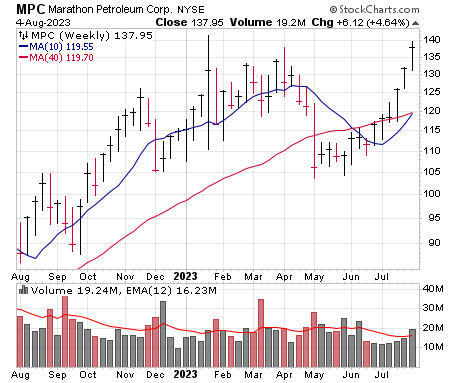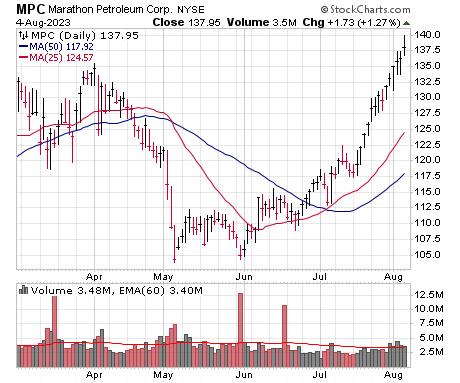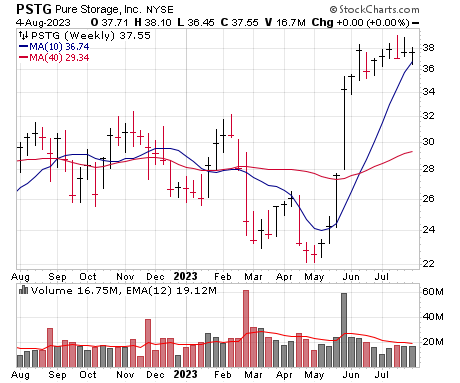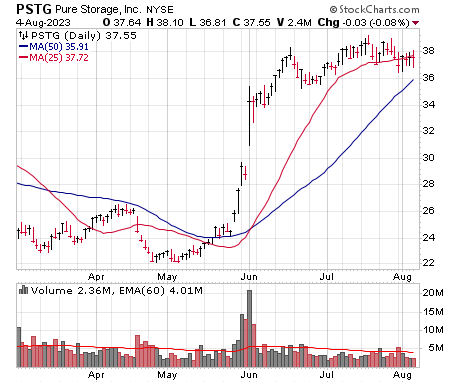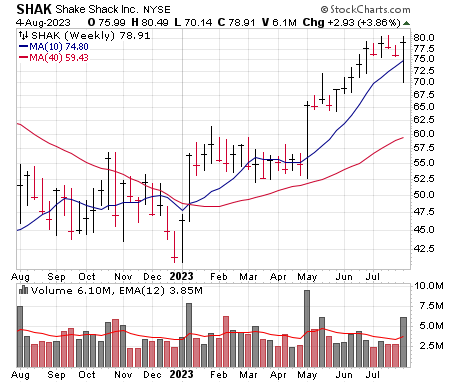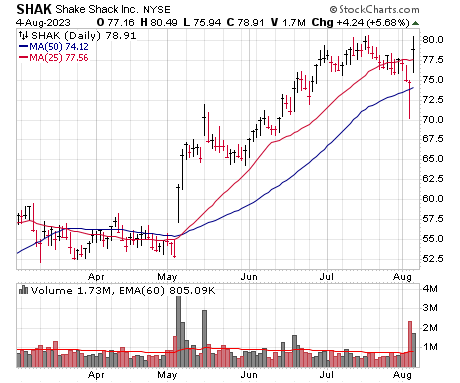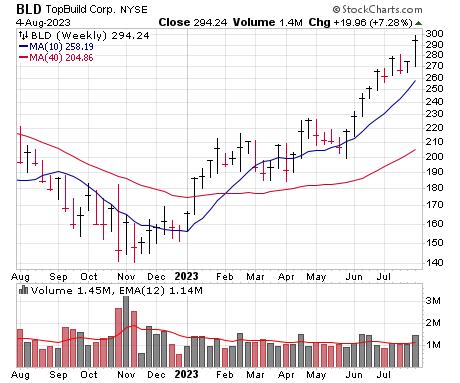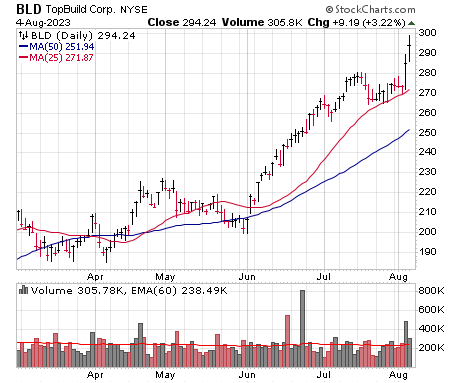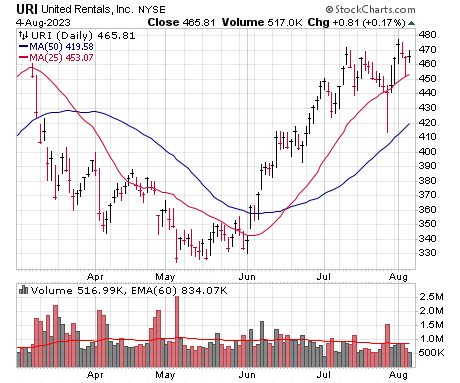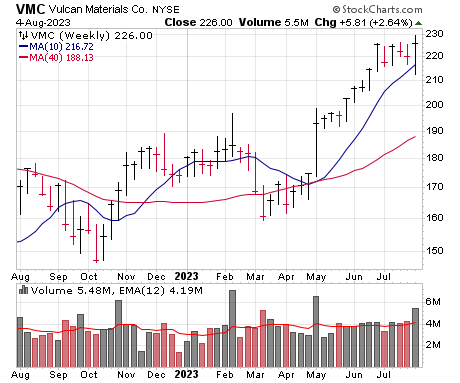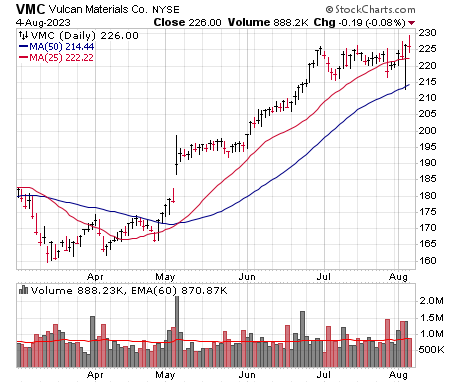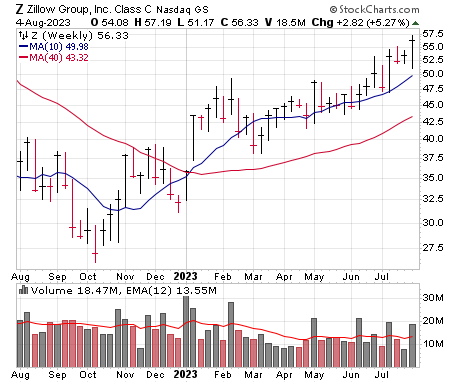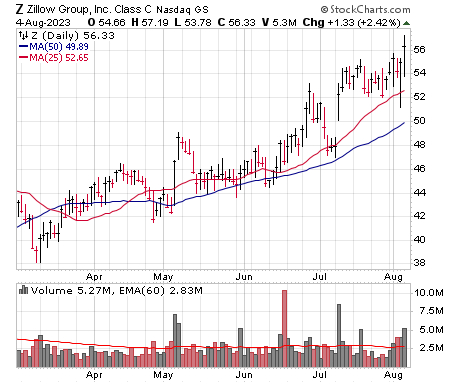Pull in Your Horns a Bit
After two-plus months where sellers really couldn’t make a dent in the market, last week was a definite change, with the major indexes down 1% to 3% on the week, with the growth-heavy Nasdaq taking the worst of the damage—and, more important to us, many growth stocks decisively cracked near- to intermediate-term support, a sign that some rest is in likely order. Now, on the flip side, the vast majority of the top-down evidence remains positive, some growth names are holding their own and a bunch of industry, energy, transport and other cyclical names are still acting fine. Put it together and we think it makes sense to pull in your horns a bit for now, respecting the selling pressure, which could take some time to play out given the recent run—but we’re also not selling wholesale, as the odds continue to strongly favor the market (and many leaders) working its way higher once this selling squall passes. We’re moving our Market Monitor down to a level 6, which translates to holding some more cash and being discerning on the buy side.
Interestingly, despite the market’s hiccup, it wasn’t hard to find a bunch of solid charts (and some solid setups) in a variety of sectors, as you’ll see in this week’s list. Our Top Pick is Boot Barn (BOOT), which looks like it’s finally emerging from a long bottoming effort.
Price |
| Boot Barn (BOOT) ★ Top Pick ★ |
| Freshworks (FRSH) |
| Marathon Petroleum (MPC) |
| Oshkosh (OSK) |
| Pure Storage (PSTG) |
| Shake Shack (SHAK) |
| TopBuild (BLD) |
| United Rentals (URI) |
| Vulcan Materials (VMC) |
| Zillow (Z) |
Stock 1
Boot Barn (BOOT) ★ Top Pick ★
Price |
Why the Strength
Boot Barn has always had a very attractive story, being by far the biggest retail chain that’s focused on western and work-related (usually blue collar) apparal and accessories—seeing success partly by filling a void in the market (most of the industry is filled by small independent players; it has three times the stores as its nearest direct competitor) but also due to the growth acceptance/popularity of the country, western and outdoor lifestyles. The firm’s business (and the stock) went gangbusters during the pandemic (sales rose 66% in 2021!!), and right now there’s a bit of a hangover—in Q2, for instance, same-store sales were down 3% (driven mostly by an 11% drop in e-commerce), though this comes after 10% and 8% same-store sales gains the prior two Q2’s. Even so, Boot Barn is strong today because business is sloughing off much less than expected and the long-term outlook has a lot going for it: First off, for the here and now, same-store sales actually turned marginally positive in June and July, all while merchandise margins lifted 0.8 percentage points in the quarter (bolstered by greater sales of many exclusive brands, which should make up nearly 40% of the total this year). And bigger picture, there’s a huge cookie-cutter story here, too, with the firm operating “only” 363 locations in 44 states, but that’s on its way to 397 by year’s end (up 15% from last year) and up to 900 down the road—all thanks to a very bullish store economics model that sees a payback of new store openings in about 15 months (75% payback in the first year). While the rest of this year should be something of a transition, it’s looking like Boot Barn is basically holding onto most of its wild earnings gains from the pandemic, with steady growth ahead. The pickup in the oil and gas sector is a side factor that should help the cause.
Technical Analysis
BOOT had a massive post-pandemic advance followed by an ugly decline (~135 to 50) during the bear, but it looked like it had turned around earlier this year, with a strong snapback to the 90 area. But then came the market’s springtime blues, and BOOT again sagged, albeit to much higher lows (64) in May. And, bullishly, the stock has rallied since then in a steady, persistent way (up nine weeks in a row), capped by a nice earnings gap last Thursday. We wouldn’t chase it here, but further weakness would be tempting.
| Market Cap | $2.99B | EPS $ Annual (Mar) | ||
| Forward P/E | 19 | FY 2022 | 6.18 | |
| Current P/E | 19 | FY 2023 | 5.57 | |
| Annual Revenue | $1.68B | FY 2024e | 5.19 | |
| Profit Margin | 8.8% | FY 2025e | 6.19 | |
| Qtrly Rev | Qtrly Rev Growth | Qtrly EPS | Qtrly EPS Growth | |
| ($M) | (vs. yr-ago-qtr) | ($) | (vs. yr-ago-qtr) | |
| Latest qtr | 384 | 5% | 1.11 | -12% |
| One qtr ago | 426 | 11% | 1.51 | 3% |
| Two qtrs ago | 515 | 6% | 1.74 | -22% |
| Three qtrs ago | 352 | 12% | 1.06 | -13% |
Weekly Chart | Daily Chart |
Stock 2
Freshworks (FRSH)
Price |
Why the Strength
When young technology and software stocks are getting nailed, it’s not hard to spot the unusual name that’s perking up—and Freshworks is a good example of that now. As opposed to some niche players, this company looks to be going head-on against many players in a variety of software verticals: It believes it has a better mousetrap when it comes to things like customer service (better omnichannel offering than Zendesk for small/mid-sized businesses; more intuitive interface and better value than Salesforce for enterprises, etc.), IT service Management (where it’s battling Atlassian and ServiceNow), marketing and more—and, to be fair, it is capturing some good-sized clients, such as Coupa, Riverbed, Discover, Amex Business Travel, TaylorMade, a subsidiary of Airbus, Sotheby’s, Stitchfix and more, with a recent focus on larger firms after spending most of its existence selling to small- and mid-sized operations. A big draw here is that its AI-enhanced offerings are already in place: In Q2, Freshworks launched its self-service AI offering, which provides personalized customer and employee interaction with conversational bots, for customer service and IT agents; that service saw 220 million interactions in Q2 alone, so it’s obviously drawing interest. There will be new pricing for that product, and then comes the firm’s AI personal assistant launch (for $29 per user per month) in the months ahead. In the meantime, business here is good—not breakneck growth, but sales are rising in the 20% range, earnings are positive and pushing ahead and free cash flow is clearly in the black. Freshworks will host an Investor Day on September 7, too, which could be a catalyst. All told this looks like a solid story that’s on the right track, and if its AI products succeed, growth could accelerate.
Technical Analysis
FRSH followed the path of most firms that came public in late 2021—there were a couple of decent weeks followed by a horrendous decline (about 80%), all in a matter of seven months or so. But then a major low came last June (at 11) and slightly higher lows were seen in November (12) and May (12 again). But the difference among FRSH and many peers is that it’s now turning strong: The stock rallied into the 18 area and then popped after earnings, and so far has held most of that move. We think further dips should provide an opportunity for a small position.
| Market Cap | $6.10B | EPS $ Annual (Dec) | ||
| Forward P/E | N/A | FY 2021 | -0.10 | |
| Current P/E | N/A | FY 2022 | -0.07 | |
| Annual Revenue | $545M | FY 2023e | 0.20 | |
| Profit Margin | N/A | FY 2024e | 0.26 | |
| Qtrly Rev | Qtrly Rev Growth | Qtrly EPS | Qtrly EPS Growth | |
| ($M) | (vs. yr-ago-qtr) | ($) | (vs. yr-ago-qtr) | |
| Latest qtr | 145 | 19% | 0.07 | N/A |
| One qtr ago | 138 | 20% | 0.03 | N/A |
| Two qtrs ago | 133 | 26% | 0.01 | N/A |
| Three qtrs ago | 129 | 33% | -0.01 | N/A |
Weekly Chart | Daily Chart |
Stock 3
Marathon Petroleum (MPC)
Price |
Why the Strength
Gasoline prices are on the rise again, partially as a result of extended shutdowns at several U.S. Gulf Coast petroleum refineries. The outages are draining gasoline stockpiles in that hub region but are also boosting refinery margins, which is a big reason for the strength behind Marathon. The integrated downstream company operates one of the nation’s largest refining systems, with a capacity of nearly three million barrels of oil per day (as well as processing a variety of light and heavy crude oils and other natural gas liquids). Marathon is experiencing its own refinery-related setback, announcing last week that a key piece of equipment at its Galveston Bay refinery in Texas could be down for the entire third quarter after a fire knocked the unit out of service in May. However, even with that unit offline—plus planned maintenance at its Mid-Continent and West Coast facilities—the company just released earnings that showed refinery demand is solid, posting a 93% refinery utilization average during Q2 with total throughput of almost three million barrels per day. Yes, compared to the sky-high prices and margins of a year ago (revenue and earnings were off a lot in Q2), things are down, but the story here is that business (which includes a still-growing midstream segment) is likely to hang onto a bunch of last year’s moonshot gains; indeed, Q2 earnings topped expectations by 16% and analysts hiked their 2023 estimates by $1.24 per share after the report (now north of $20 for the year). That means the valuation is dirt cheap right now, and the top brass is returning gobs of money to shareholders—100% of operating cash flow, in fact, which equated to $3.4 billion of dividends (2.2% yield) and especially share buybacks (share count down 22% from a year ago and 11% from the start of the year!!), with another $800 million of shares bought back in July alone. For Q3, Marathon expects total refinery throughput to edge slightly higher compared to Q2 and sees refining margins being “healthy” through the rest of the year, boosted by recovering air travel. It’s not changing the world, but business is stronger than expected and the share buybacks are eye-opening.
Technical Analysis
MPC was in great shape for most of 2022 and choppily moved higher despite significant energy sector headwinds early this year; shares finally ran out of gas at 139 in early April and had a quick 20% drop that brought shares below their 40-week line. Still, MPC tightened up in May, nosed higher in June and has picked up steam in July, racing just above its prior highs. Given that shares are up near resistance, we’ll set our buy range down a bit.
| Market Cap | $55.6B | EPS $ Annual (Dec) | ||
| Forward P/E | 7 | FY 2021 | -10.79 | |
| Current P/E | 5 | FY 2022 | 26.16 | |
| Annual Revenue | $159B | FY 2023e | 20.20 | |
| Profit Margin | 7.8% | FY 2024e | 13.26 | |
| Qtrly Rev | Qtrly Rev Growth | Qtrly EPS | Qtrly EPS Growth | |
| ($B) | (vs. yr-ago-qtr) | ($) | (vs. yr-ago-qtr) | |
| Latest qtr | 36.8 | -32% | 5.32 | -50% |
| One qtr ago | 35.1 | -9% | 6.09 | 309% |
| Two qtrs ago | 40.1 | 13% | 6.65 | 412% |
| Three qtrs ago | 47.2 | 45% | 7.81 | 970% |
Weekly Chart | Daily Chart |
Stock 4
Oshkosh (OSK)
Price |
Why the Strength
Indiana-based Oshkosh builds vehicles and vehicle bodies for the access, defense, fire & emergency, refuse collection and concrete placement markets. For years, the company was best known for being the key supplier of Humvees for the U.S. Army, and later, for the Joint Light Tactical Vehicles (JLTV, the Humvee’s replacement). But earlier this year, the company lost its JLTV contract with the Army, forcing the firm to focus more on its growing commercial truck business. To that end, Oshkosh recently acquired AeroTech, a leading provider of aviation ground support products, gate equipment and airport services; the deal is expected to deliver solid recurring revenue for Oshkosh via its aftermarket parts and services offerings and prompted a major Wall Street institution to upgrade the stock (a reason for the strength). Meanwhile, the vocational segment (fire trucks especially) is so strong the firm is looking to boost capacity, while defense isn’t all bad, with the firm recently inking a $200 million contract to modify medium trucks to be sent to Ukraine as part of an assistance initiative. Add it up and business is very, very good: Demand remains strong across the board, leading to a 17% revenue gain in Q2, while earnings mushroomed (and crushed expectations by more than a dollar) as supply chain issues eased and margins expanded. The backlog of $15 billion (up $2 billion from a year ago) is elevated, too, which is one reason management hiked its 2023 outlook to $8 per share. Throw in a 1.6% dividend and a reasonable valuation and there’s a lot to like from this machinery outfit.
Technical Analysis
OSK fell from 137 to 70 during the bear market, bottoming out last September, and after a nice rally into February of this year, essentially retested that low in May (egged on by the loss of the Army contract, which cut shares down by 11% in one day). But the turnaround started after that, with a fairly persistent upmove—capped by last week’s huge-volume earnings rally back to its February highs. We’ll set our entry range down a bit, though we’re not expecting a huge retreat.
| Market Cap | $6.85B | EPS $ Annual (Dec) | ||
| Forward P/E | 14 | FY 2021 | 4.71 | |
| Current P/E | 15 | FY 2022 | 3.34 | |
| Annual Revenue | $8.95B | FY 2023e | 7.56 | |
| Profit Margin | 7.3% | FY 2024e | 8.49 | |
| Qtrly Rev | Qtrly Rev Growth | Qtrly EPS | Qtrly EPS Growth | |
| ($B) | (vs. yr-ago-qtr) | ($) | (vs. yr-ago-qtr) | |
| Latest qtr | 2.41 | 17% | 2.69 | 449% |
| One qtr ago | 2.27 | 17% | 1.59 | 489% |
| Two qtrs ago | 2.20 | 23% | 1.60 | 999% |
| Three qtrs ago | 2.07 | 0% | 1.00 | -5% |
Weekly Chart | Daily Chart |
Stock 5
Pure Storage (PSTG)
Price |
Why the Strength
Plenty of corporate data farms are still based on long-used structures that include physical servers on-site and spinning disk drives. But the world is rapidly moving toward all-flash drive and cloud-oriented data storage, a trend Pure Storage is ideally positioned to take advantage of. Pure Storage is a cloud-based storage-as-a-service business that pitches corporate customers on abandoning their legacy data archiving operations and switching to Pure Storage to save money and cut risk, since flash is both cheaper at scale and not prone to physical breakdowns like even the most reliable hard drives. Its appeal is bolstered by the fact that flash storage uses significantly less energy than older systems, giving it a green angle, too. There are lots of cloud storage players but management says Pure is different because the company operates only flash drives, giving it an operational and cost edge. The company says customers pay roughly half of what a traditional provider charges, and as a client’s operations get larger, economies of scale should hammer that down even further. The company also guarantees that the storage systems being used will continually be updated to stay technologically current. Investment-wise, the need for more storage due to the AI boomet is helping now, but big picture, Pure’s move toward more subscription-based offerings promises smoother growth ahead—in the quarter ending April, Pure’s annualized recurring revenue was $1.2 billion (up 29%), which was about half of sales but is becoming a much bigger slice of the pie. Throw in continued customer acquisitions (11,500 clients, including 58% from the Fortune 500, up from 10,000 and 54% a year ago, respectively) and surging remaining performance obligations ($1.8 billion, up 26%) and big investors are expecting accelerating growth ahead. Earnings are due August 23.
Technical Analysis
PSTG tested all-time highs in late 2021 and again in the spring of 2022 before finally giving up the ghost and meandering sideways-to-lower for the next year. The AI boom helped the stock this spring, with shares surging back to their prior highs on noteworthy volume—and we’re impressed the calm, tight trading action since as the 10-week line has caught up. We’re OK with a small buy around here with a tight-ish stop.
| Market Cap | $11.7B | EPS $ Annual (Jan) | ||
| Forward P/E | 28 | FY 2022 | 0.78 | |
| Current P/E | 30 | FY 2023 | 1.32 | |
| Annual Revenue | $2.72B | FY 2024e | 1.38 | |
| Profit Margin | 4.2% | FY 2025e | 1.66 | |
| Qtrly Rev | Qtrly Rev Growth | Qtrly EPS | Qtrly EPS Growth | |
| ($M) | (vs. yr-ago-qtr) | ($) | (vs. yr-ago-qtr) | |
| Latest qtr | 589 | -5% | 0.08 | -68% |
| One qtr ago | 810 | 14% | 0.53 | 47% |
| Two qtrs ago | 676 | 20% | 0.31 | 41% |
| Three qtrs ago | 647 | 30% | 0.32 | 129% |
Weekly Chart | Daily Chart |
Stock 6
Shake Shack (SHAK)
Price |
Why the Strength
Shake Shack is a burger joint, offering very tasty burgers, dogs, shakes, fries and more, and doing a good enough job of it to gain a very loyal following. Investment-wise, there are two big attractions here, the first being the firm’s huge cookie-cutter story: Shake Shack ended Q2 with 471 total locations (both operated, which are usually domestic, and licensed, usually overseas), up 23 from the prior quarter and up a big 19% from a year ago, with another 23 openings on tap for Q3. However, the bigger story right now is the dirty work the company is doing behind the scenes—thanks in part to an activist investor (Engaged Capital, which got some board seats in May), the firm is tightening the reins on costs and boosting efficiency, which is starting to flow to the bottom line. In Q2, the top line was up 18% (actually accelerated a bit late in the quarter and into July) while system-wide sales rose 22% and same-store sales were up 3%, but more important were the margins, with restaurant-level operating profits coming in at 21% of revenue, up from 18.6% a year ago, and that helped EBITDA come in at 13.6% of revenues, the biggest margin in the firm’s history! And there should be more to come: New store opening costs have surged with inflation the past couple of years, but the top brass thinks it can cut those costs by 10% in 2024, while there should be continued improvement in store-level expenses (kiosks, more dynamic staff scheduling, reducing costs for to-go orders), too. Granted, it’s not all peaches and cream (traffic is flat-ish at its stores, food inflation continues to be a challenge), but the top brass did hike the outlook for the rest of the year and, big picture, the combination of controlled costs and new store openings could drive EBITDA and cash flow much higher down the road.
Technical Analysis
SHAK had a multi-month bottoming phase that ended with a very tight launching pad earlier this year. The breakout on Q1 earnings was solid (it was our Top Pick in the May 8 issue), and after a little hesitation, the stock rallied nicely to the 80 area. Then came the pullback: SHAK started to retreat normally but then had a huge initial dip on the Q2 numbers (falling as low as 70) before rebounding sharply Thursday afternoon and especially Friday … forming what looks to be a huge shakeout. Expect gyrations, but it looks buyable here or (preferably) on a little retrenchment.
| Market Cap | $3.40B | EPS $ Annual (Dec) | ||
| Forward P/E | 348 | FY 2021 | -0.06 | |
| Current P/E | 999 | FY 2022 | -0.33 | |
| Annual Revenue | $992M | FY 2023e | 0.23 | |
| Profit Margin | 2.9% | FY 2024e | 0.34 | |
| Qtrly Rev | Qtrly Rev Growth | Qtrly EPS | Qtrly EPS Growth | |
| ($M) | (vs. yr-ago-qtr) | ($) | (vs. yr-ago-qtr) | |
| Latest qtr | 272 | 18% | 0.18 | N/A |
| One qtr ago | 253 | 25% | -0.01 | N/A |
| Two qtrs ago | 239 | 17% | -0.06 | N/A |
| Three qtrs ago | 228 | 17% | -0.06 | N/A |
Weekly Chart | Daily Chart |
Stock 7
TopBuild (BLD)
Price |
Why the Strength
After a down year in the residential housing market in 2022, housing starts in the U.S have been trending higher this year—however, new and existing homes are still undersupplied, which is good news for thermal insulation distributor TopBuild (covered in the June 20 issue). The company’s residential installation segment—it’s primary end market—continues to benefit from a sizable backlog of single and multifamily homes under construction, but it’s also benefiting from strong building activity in the commercial and industrial end markets (37% of sales). TopBuild is also benefiting from rising demand for more energy-efficient homes and buildings in the wake of higher utility bills and increasingly stringent regulations. What’s more, the company has been growing through acquisitions, most recently adding North American insulation distributor SPI to its portfolio. This is the third residential insulation acquisition for TopBuild this year, and they should contribute around $170 million of annual revenue (the company has purchased a total of 28 companies since 2017, increasing its addressable market by 70%). The positive effect of this accretive growth was emphasized by management in last week’s earnings call, which featured revenue of $1.3 billion that rose 3% year-on-year in Q2, while adjusted EBITDA increased 14% and earnings of $5.25 a share beat estimates by a giant 90 cents (reasons for the stock’s strength and driven by a “favorable operating environment” and “robust bidding activity”). Looking ahead, TopBuild expects improvement in the residential market in the second half of 2023 as well. Big picture, this is a story about a firm that saw earnings mushroom last year, and instead of retrenching like most thought, the bottom line is holding at a new, step-function-higher level, with room for upside going forward.
Technical Analysis
Like most building material stocks, BLD had a rough 2022, but after bottoming in October, shares rallied nicely into early February. The market then struggled, but this stock held firm, effectively marking time into early June—and then the buyers took control, with BLD rallying persistently to 281, dipping to the 25-day line and pushing to new highs after earnings. Look for dips if you want in.
| Market Cap | $9.44B | EPS $ Annual (Dec) | ||
| Forward P/E | 15 | FY 2021 | 10.85 | |
| Current P/E | 15 | FY 2022 | 17.11 | |
| Annual Revenue | $5.15B | FY 2023e | 16.84 | |
| Profit Margin | 12.7% | FY 2024e | 18.14 | |
| Qtrly Rev | Qtrly Rev Growth | Qtrly EPS | Qtrly EPS Growth | |
| ($B) | (vs. yr-ago-qtr) | ($) | (vs. yr-ago-qtr) | |
| Latest qtr | 1.32 | 3% | 5.25 | 19% |
| One qtr ago | 1.27 | 8% | 4.36 | 25% |
| Two qtrs ago | 1.26 | 19% | 4.40 | 41% |
| Three qtrs ago | 1.30 | 54% | 4.80 | 63% |
Weekly Chart | Daily Chart |
Stock 8
United Rentals (URI)
Price |
Why the Strength
The powerful effects of U.S. and Canadian infrastructure spending have been a boon for the overall equipment tool and equipment rental industry, especially United Rentals. The company is the market share leader (15% share) in the North American equipment rental sector, with a $20 billion fleet consisting of around 4,600 equipment classes and nearly 700,000 units, with business split nearly evenly between industrial and non-residential construction end uses. United just increased its outlook for the rest of this year after reporting record results in Q2, a quarter that saw “broad-based demand,” most notably in the industrial manufacturing, metals and minerals and power sectors. Revenue of $3.5 billion soared 28% from the year-ago quarter, thanks to a 21% increase in rental sales and a 130% increase in used equipment sales (in part influenced by a recent acquisition). Adjusted EBITDA jumped 30%, while per-share earnings of $9.88 beat estimates by 94 cents. Significantly, return on invested capital (ROIC, a critical metric) set a new record at 13% on a trailing 12-month basis, remaining “well above” the company’s average cost of capital. United also said supply chain improvements have allowed it to refresh its fleet by rotating out some of its older assets, while new projects across the board (particularly in semiconductor plants, solar power facilities and infrastructure projects) drove growth in Q2. Total revenue for this year is now expected by the top brass to come in around $14 billion, implying a 22% increase from last year, with adjusted EBITDA of around $7 billion representing a 25% leap from 2022. Better yet, despite the massive earnings boom in the past couple of years, United sees 2024 as likely being even better than this year, and Wall Street agrees. It’s a solid construction and infrastructure-related story.
Technical Analysis
URI peaked in November 2021 with the market and sank to 45% to its nadir in June of last year. The rally from there was jagged, but impressive, and took the stock all the way to new high ground—before the March 2023 banking crisis hammered all cyclical stocks. Even so, after a dip under the 40-week line, URI began to march back in June and, following a post-earnings shakeout two weeks ago, has rallied back to new highs. Any near-term exhale would be tempting.
| Market Cap | $32.1B | EPS $ Annual (Dec) | ||
| Forward P/E | 12 | FY 2021 | 22.06 | |
| Current P/E | 13 | FY 2022 | 32.49 | |
| Annual Revenue | $13.2B | FY 2023e | 40.06 | |
| Profit Margin | 19.1% | FY 2024e | 42.76 | |
| Qtrly Rev | Qtrly Rev Growth | Qtrly EPS | Qtrly EPS Growth | |
| ($B) | (vs. yr-ago-qtr) | ($) | (vs. yr-ago-qtr) | |
| Latest qtr | 3.55 | 28% | 9.88 | 26% |
| One qtr ago | 3.29 | 30% | 7.95 | 39% |
| Two qtrs ago | 3.30 | 19% | 9.74 | 32% |
| Three qtrs ago | 3.05 | 18% | 9.27 | 41% |
Weekly Chart | Daily Chart |
Stock 9
Vulcan Materials (VMC)
Price |
Why the Strength
The nationwide infrastructure spending boom is an ongoing theme that should translate into massive demand for construction aggregates like cement, concrete and asphalt for years to come. Vulcan (covered in the June 12 issue) is the nation’s largest provider of these ingredients—primarily crushed stone, sand and gravel—and is also a major producer of aggregates-based construction materials like asphalt and ready-mixed concrete. Its customers include builders of highways, walkways, airports and railroads, as well as residential and commercial building developers, so the addressable market is very expansive. Last week, Vulcan released Q2 results that saw revenue increase 8% from a year ago, earnings of $2.29 per share that topped estimates by 37 cents and adjusted EBITDA of nearly $600 million (up 32%). The solid numbers were driven by aggregate sales to large industrial and residential projects, with construction activity on both fronts being “better than expected”—a trend Vulcan sees carrying through the rest of the year. The company’s Asphalt, Concrete and Calcium segment saw a 16% increase in shipments in Q2, benefiting from “solid growth” in California and Arizona (its largest markets) and helped by across-the-board price increases. An additional highlight was the firm’s 22% improvement in gross profit per ton (a key metric) in the Aggregates segment, a key sub-metric that’s improved steadily during the past two years. Management sees the residential housing market starting to pull its weight in the months ahead, too, which could provide an added boost to results. All in all, EBITDA should rise 20% this year, with 2024 likely to bring similar growth.
Technical Analysis
As with many cyclical stocks, VMC hit its lows last fall, rallied into February, and then suffered another knock across the head during the banking crisis in March. But shares then tightened up in March and April and gapped up on earnings in May, kicking off a very solid run to the 225 area in June. Progress halted at that point, but VMC refused to give up any ground—and even a post-earnings shakeout to the 50-day line was met with buying. We expect more volatility near term, but buying here or on dips with a stop just under the recent lows is a solid risk/reward situation.
| Market Cap | $30.2B | EPS $ Annual (Dec) | ||
| Forward P/E | 34 | FY 2021 | 5.05 | |
| Current P/E | 37 | FY 2022 | 5.12 | |
| Annual Revenue | $7.58B | FY 2023e | 6.62 | |
| Profit Margin | 14.5% | FY 2024e | 7.92 | |
| Qtrly Rev | Qtrly Rev Growth | Qtrly EPS | Qtrly EPS Growth | |
| ($B) | (vs. yr-ago-qtr) | ($) | (vs. yr-ago-qtr) | |
| Latest qtr | 2.11 | 8% | 2.29 | 50% |
| One qtr ago | 1.65 | 7% | 0.95 | 30% |
| Two qtrs ago | 1.73 | 8% | 1.08 | -14% |
| Three qtrs ago | 2.09 | 38% | 1.78 | 16% |
Weekly Chart | Daily Chart |
Stock 10
Zillow (Z)
Price |
Why the Strength
The housing market is sluggish – real estate sales volumes fell 22% in the second quarter thanks to still-elevated home prices and mortgage rates. But Zillow performed better than the market in the period and last week announced numbers that blew away consensus expectations, with revenue of $506 million (compared to $473 million consensus) and net income of 39 cents a share (versus 18 cents expected). The strength suggests that when housing activity starts to recover in 2024, as many predict, Zillow should be able to cash in. While there’s obviously competition, Zillow is the big dog here, as the firm claims a whopping two-thirds of U.S. home seekers use their app, mostly for browsing real estate listings. The company aggregates and displays listings in a user-friendly map with area and demographic data people find useful. Zillow makes most of its revenue by splitting commissions on buyers who find an agent through the app and then close on a house, generating about $4,100 a deal. But less than 1% of Zillow users lead to any revenue for the company, so increasing that percentage is the main focus of management. Zillow is using the downturn to roll out its “super app,” a collection of new tools and initiatives to claim more of the $17,000 in average homebuyer fees they feel is up for grabs. That includes connecting mortgage lenders with buyers, offering closing services and getting sellers and agents to use ShowingTime+, a fee-based tech service that improves listings by automating photos, virtual tours and layouts for properties. Zillow’s business in rental listings is less well known but is growing fast, with rental revenue rising 28% as the company’s app moved into the top slot in the industry. The rest of this year will still likely show flat-ish results, but the market is looking ahead to brighter times when housing turnover increases and (eventually) mortgage rates back off.
Technical Analysis
Z was crushed during the bear market to no one’s surprise, though it had a nice rally off its lows in October through January before starting its first, fresh launching pad. That process took a while and had a few false starts (one in May, another in late June), but now it looks like Z has finally moved out on the upside, with strong earnings support on Thursday (after a brief dip) and Friday last week. If you’re game, a small wiggle should be buyable, with a stop under 50.
| Market Cap | $13.0B | EPS $ Annual (Dec) | ||
| Forward P/E | 41 | FY 2021 | 1.58 | |
| Current P/E | 41 | FY 2022 | 1.43 | |
| Annual Revenue | $1.89B | FY 2023e | 1.40 | |
| Profit Margin | 19.6% | FY 2024e | 1.90 | |
| Qtrly Rev | Qtrly Rev Growth | Qtrly EPS | Qtrly EPS Growth | |
| ($M) | (vs. yr-ago-qtr) | ($) | (vs. yr-ago-qtr) | |
| Latest qtr | 506 | 0% | 0.39 | 3% |
| One qtr ago | 469 | -13% | 0.35 | -20% |
| Two qtrs ago | 435 | -19% | 0.21 | -38% |
| Three qtrs ago | 483 | -12% | 0.38 | 0% |
Weekly Chart | Daily Chart |
Previously Recommended Stocks
| Date | Stock | Symbol | Top Pick | Original Buy Range | 8/7/23 |
| HOLD | |||||
| 7/24/23 | 28-29.5 | 27 | |||
| 7/31/23 | Aehr Test Systems | AEHR | 48.5-51 | 48 | |
| 7/17/23 | 138-144 | 143 | |||
| 6/20/23 | 74-76.5 | 86 | |||
| 7/24/23 | 505-520 | 484 | |||
| 7/3/23 | ★ | 43-44.5 | 45 | ||
| 7/24/23 | 99.5-102.5 | 101 | |||
| 7/24/23 | ★ | 103-106 | 104 | ||
| 7/31/23 | Boeing | BA | 234-239 | 238 | |
| 5/15/23 | ★ | 123-128 | 143 | ||
| 7/24/23 | 33-34.5 | 36 | |||
| 7/17/23 | 155-161 | 164 | |||
| 7/3/23 | 43.5-45 | 43 | |||
| 3/13/23 | 17.3-18.0 | 32 | |||
| 7/17/23 | 18.7-19.1 | 21 | |||
| 7/31/23 | KLA Corp. | KLAC | 502-515 | 506 | |
| 7/31/23 | Microstrategy | MSTR | 415-430 | 371 | |
| 7/17/23 | 34.5-36 | 44 | |||
| 5/22/23 | Monday.com | 146-153 | 163 | ||
| 7/20/23 | ★ | 45-47 | 52 | ||
| 2/27/23 | 225-230 | 454 | |||
| 7/31/23 | Old Dominion Freight | ODFL | 393-408 | 409 | |
| 7/17/23 | 69-71.5 | 72 | |||
| 7/31/23 | Palantir | PLTR | 17.8-18.7 | 18 | |
| 7/24/23 | 99-103 | 108 | |||
| 7/17/23 | 28.5-30.5 | 29 | |||
| 7/10/23 | 26-27.5 | 25 | |||
| 5/8/23 | ★ | 63-65 | 80 | ||
| 11/21/22 | 44-46 | 66 | |||
| 7/31/23 | Southern Copper | SCCO | ★ | 83-86 | 84 |
| 7/3/23 | 16.2-16.8 | 18 | |||
| 7/17/23 | 56.5-58 | 62 | |||
| 7/31/23 | Transocean | RIG | 8.0-8.5 | 8 | |
| 5/8/23 | 37-39 | 45 | |||
| 6/12/23 | Vulcan Materials | VMC | ★ | 203-207.5 | 229 |
| WAIT | |||||
| 7/31/23 | 37-38.5 | 42 | |||
| 7/31/23 | RH Inc. | RH | 360-375 | 402 | |
| SELL RECOMMENDATIONS | |||||
| 7/17/23 | 48.5-50.5 | 42 | |||
| 7/10/23 | 138-142 | 126 | |||
| 6/20/23 | 158-163 | 181 | |||
| 6/26/23 | ★ | 31-33 | 34 | ||
| 6/26/23 | 91-94 | 106 | |||
| 7/24/23 | 44-46 | 36 | |||
| 6/12/23 | 34.5-36.5 | 34 | |||
| 7/10/23 | 48-50 | 50 | |||
| 3/20/23 | 378-388 | 494 | |||
| 7/10/23 | 119-125 | 109 | |||
| 5/8/23 | 388-398 | 462 | |||
| 6/5/23 | 103-106 | 96 | |||
| 6/5/23 | ★ | 221-226 | 215 | ||
| 6/12/23 | 62.5-65 | 65 | |||
| 6/12/23 | ★ | 61.5-63.5 | 58 | ||
| 7/24/23 | United Airlines | UAL | 54-56.5 | 54 | |
| DROPPED | |||||
| 7/24/23 | 80.5-82.5 | 86 | |||
| 7/24/23 | 71-74 | 83 | |||
The next Cabot Top Ten Trader issue will be published on August 14, 2023.

